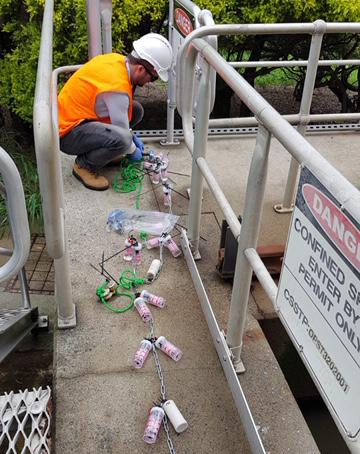The vision for our original SewAus Census 2016 project, that has led to the SewAus Census 2021 project, was to evaluate the feasibility of a nationwide sampling program coordinated to link with the ABS Census. The impact of the SewAus Census 2016 project was crucial to the adoption of wastewater-based monitoring of licit and illicit drugs in Australia. The SewAus Census 2021 will harness and enhance the outcomes of SewAus Census 2016.
If you would like to participate in the SewAus project or would like more information, please contact us.
Wastewater-based epidemiology (WBE) is a monitoring approach increasingly being used to assess temporal and spatial trends in population chemical consumption, use and exposure. Wastewater-based epidemiology is rapidly expanding from its earliest applications, to measure the use of illicit drugs, to monitoring chemical biomarkers for populations. These biomarkers can provide information on consumption/exposure to chemicals and, more recently, population health by monitoring patterns of pharmaceutical use and/or biomarkers of disease. Wastewater-based epidemiology provides data complementary to traditional survey techniques, with clear advantages in cost effectiveness and objectivity.
Wastewater-based epidemiology is currently applied in more than 70 countries worldwide, including through the collaborative network, the Sewage Analysis CORe Group Europe (SCORE) (co-founded by Prof Kevin Thomas, Director of QAEHS). Wastewater-based epidemiology has been embraced by key law enforcement and drug addiction agencies in Europe through the European Monitoring Centre for Drug and Drug Addiction (EMCDDA). In Australia, our work on wastewater-based epidemiology has led to implementation of the world-first National Wastewater Drug Monitoring Program (NWDMP), supported by the Australian Criminal Intelligence Commission (ACIC), to routinely monitor consumption trends of a range of substances in wastewater covering approximately 50% of the Australian population.
Recently, wastewater-based epidemiology has been extended to monitor other parameters of public health importance, such as biomarkers that are used in clinical or biomonitoring contexts.
Samples collected during the Australian Bureau of Statistics’ (ABS) Census 2021 will form the basis of a rich and unique databank that describes how communities are exposed to chemical and biological hazards, and how these chemicals/biological agents are released into the environment following wastewater treatment. Our previous ARC-funded SewAus Census 2016 project successfully established the first, globally unique nationwide program for wastewater-based monitoring of chemicals. In SewAus Census 2016, we demonstrated the utility of integrating wastewater-based monitoring with detailed, accurate data on the population that contributed to the sample from the ABS Census. Demographic and socioeconomic data, such as age or occupation, were used to explain patterns of drug use and other chemical exposure in the population.
We aim to assess human use and exposure to chemicals including drugs, pharmaceuticals, lifestyle chemicals, and unintentional exposure to environmental pollutants in the Australian population through the systematic collection and analysis of wastewater. After the success of the SewAus Census 2016 project, we aim to conduct longitudinal sampling on each anniversary of the Census. We aim to provide accurate and objective per-capita based consumption and release estimates for a wide range of chemicals and how these are changing over time.
Influent and effluent samples:
- 7 x 24 hour integrated samples on consecutive days
- Ideally we want high-frequency flow-proportional samples. If not, high-frequency time-proportional samples. We will ask operators to optimise on-site autosamplers
- If weekends are problematic, we will aim for a composite sample covering Saturday and Sunday
- From each daily integrated influent and effluent sample, three subsamples of each to be taken. The acid and preservative provided should be added to the subsamples labelled as: Acidified and Preserved
- Sites without autosamplers will be provided with passive samplers as will some sites with autosamplers to further calibrate the passive samplers
Biosolids:
- 1 x Composite sample of 2 or more subsamples

Passive samplers: What are they?
- Passive samplers are small tubes filled with a substance that passively accumulates chemicals over time
- We can submerge these in influent or effluent over several days/weeks to determine presence and concentration of chemical substances
- Passive samplers can be used for measuring chemicals such as pesticides, pharmaceuticals and drugs
Why passive samplers?
- Simple design consists of ready to deploy rope and chain, requiring no power.
- Simple deployment: tie rope to structure, remove caps, submerge samplers into wastewater influent or effluent streams, leave for 1 week. Remove from wastewater, recap and send back.
- Our goal is to be able to use these devices in locations where power or resources preclude the use of active composite sampling.
- They can be easily deployed to obtain data at sites where Autosamplers are not available/possible.
Important Information
- QAEHS will supply collection bottles, passive samplers, labels, eskies, preservative/acid and pre-paid courier slips.
- All WWTPs will be contacted individually prior to sampling to discuss requirements for that site. Site-specific sampling instructions will be provided with the packs sent out.
- We will ask for a questionnaire to be completed during/after sampling. A “help-desk” will be available for the sampling period to answer queries and to help with completing the questionnaire. All results continue to be de-identified to maintain WWTP confidentiality and will be provided back to WWTPs.
Sample handling - Samples to be frozen and couriered to QAEHS in one delivery post sampling (all supplied by QAEHS).
2025
2024
Simpson, J., Simpson, B.S. and Gerber, C., 2024. A LC-MS/MS method for the simultaneous quantification of 17 opioids in biosolids. Talanta, p.125775.
2023
2022
2021
2020
2019
2018
